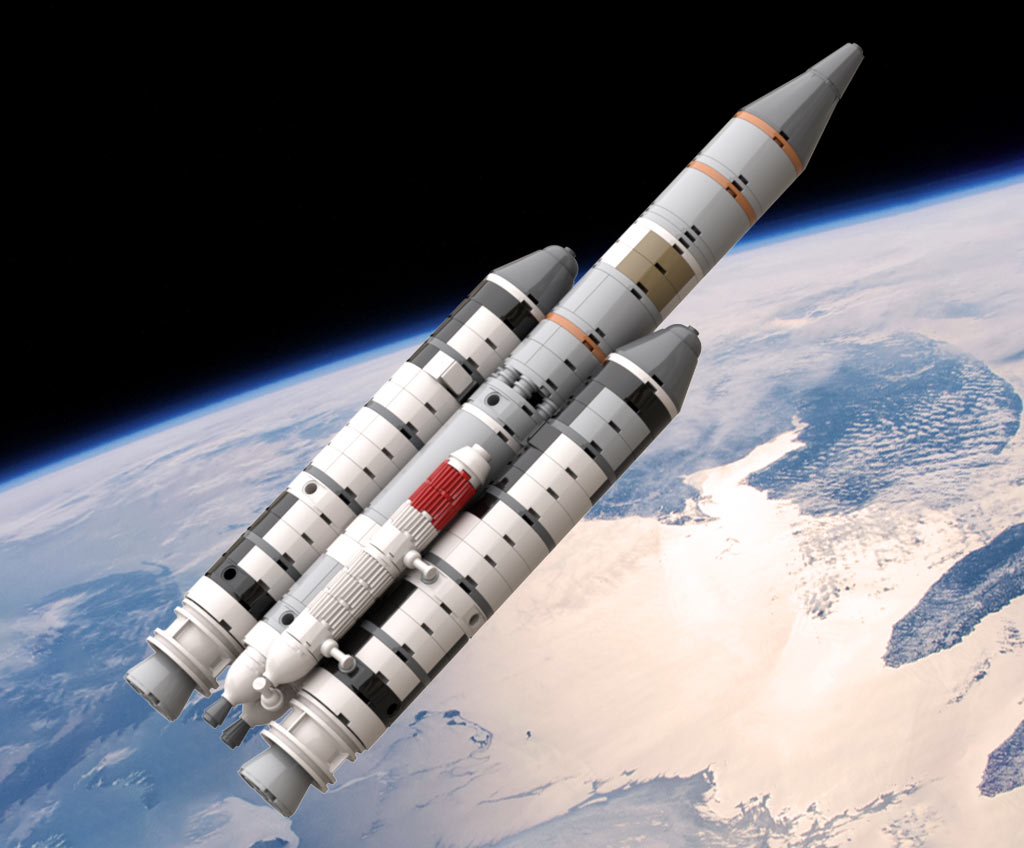
LEGO Designer:
Grant Passmore (Eiffelman)
Designed:
April 2018
Categories:
Launch Vehicles, All, Medium Lift Launch Vehicle, Space Agency - NASA
Further Information and References:
Wikipedia
Astronautix
Drew Ex Machina : The Future that Never Came
Launch Vehicle Details
Stages:
3 stage + strap-on boosters
Length:
38.3 m
Diameter:
3.05 m
Mass at Launch:
626.2 tonnes
Low Earth Orbit Capacity:
13300 kg
Total Thrust:
10600 kN
Apogee:
40000 km
Class:
Medium Lift Launch Vehicle
Titan IIIC was originally designed to launch the X-20 Dynasoar, but when the spaceplane was cancelled, it was used as an expendable launcher for Department of Defence and NASA payloads.
It was the first of the Titan family to feature solid rocket boosters: two UA1205s. The addition of the boosters led to a 10x increase in liftoff thrust, with each one producing over ten mega-newtons of thrust at sea level. Eight solid separation motors on each booster would push them away from the rocket 110 seconds into the flight.
The first and second stages, also known as the core stages, were derived from earlier Titan variants. A shroud was fitted over the first stage LR-87 engine to protect it from the SRB exhaust. The engine was air-lit approximately 10 seconds before booster cutoff and separation. Like earlier Titan rockets, the second stage was ‘hot staged’, with its LR-91 engine ignited while the first stage was still firing. This eliminated the need for ullage motors, but required the installation of holes in the interstage (blast ports) to allow the exhaust out the sides before separation. Titan IIIC+ used the same basic airframe, but with improved engines.
The Titan III introduced the Trans-stage. With restartable engines, it allowed for more flexible in-orbit operations. All liquid fuelled stages ran on Aerozine 50 and Nitrogen Tetroxide.
The rocket had a 10ft (3.05m) wide conical payload fairing, which would have been replaced by the X-20 or MOL (Manned Orbiting Laboratory) on the planned, but never launched crewed flights.
Downloads
Part count: 343 bricks, 79 lots.
| Unit | width | length | height |
|---|---|---|---|
| Studs | 12 | 7.1 | 51 |
| Inches | 3.8 | 2.2 | 16.1 |
| Centimetres | 9.6 | 5.6 | 40.8 |
No: Serial: Type: Date LS Payload
1 1 3C-7 Titan-3C 18.06.1965 CC LC-40 Transtage 5
2 2 3C-4 Titan-3C 15.10.1965 f CC LC-40 LCS 2 / OV2 1
3 3 3C-8 Titan-3C 21.12.1965 p CC LC-41 LES 3 / LES 4 / OV2 3 / OSCAR 4
4 4 3C-11 Titan-3C 16.06.1966 CC LC-41 IDCSP 1 ... IDCSP 7 / GGTS 1
5 5 3C-12 Titan-3C 26.08.1966 F CC LC-41 IDCSP (8) ... IDCSP (14) / GGTS 1
6 6 3C-9 Titan-3C 03.11.1966 CC LC-40 OV4 3 / OV4 1R / OV4 1T / OV1 6 / Gemini B*
7 7 3C-13 Titan-3C 18.01.1967 CC LC-41 IDCSP 8 ... IDCSP 15
8 8 3C-10 Titan-3C 28.04.1967 CC LC-41 Vela 7 / Vela 8 / ORS 4 / OV5 1 / OV5 3
9 9 3C-14 Titan-3C 01.07.1967 CC LC-41 IDCSP 16, 17, 18, 19-DATS / LES 5 / DODGE
10 10 3C-16 Titan-3C 13.06.1968 CC LC-41 IDCSP 19 ... IDCSP 26
11 11 3C-5 Titan-3C 26.09.1968 CC LC-41 LES 6 / OV2 5 / OV5 2 / OV5 4
12 12 3C-17 Titan-3C 09.02.1969 CC LC-41 TACSAT 1
13 13 3C-15 Titan-3C 23.05.1969 CC LC-41 Vela 9 / Vela 10 / OV5 5 / OV5 6 / OV5 9
14 14 3C-18 Titan-3C 08.04.1970 CC LC-40 Vela 11 / Vela 12
* = Gemini B was on a suborbital trajectory
[..] = Additional stages considered part of the payload
Launch sites:
CC = Cape Canaveral Air Force Station, Eastern Test Range, Cape Canaveral, Florida, USA
Launch History information from space.skyrocket.de
Launch History information from space.skyrocket.de
Related Posts
None found

